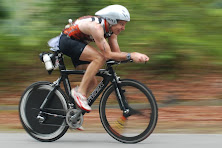Simon says: - From time to time I've debated this point on long (and usually hilly bike rides with Sam). We've never really concluded much and depending on where we're at with our training or what our mindset is that year we'll focus on spinning up the hills or powering up them or a bit of both but never really knowing what is the sensible and most efficient thing to do. This article certainly helps in the great debate.
 Varying our positions on the bike is required in order to adapt to different terrain or riding situations, or simply to give our body a break from being stuck in the same position and stressing the same muscles. While we know that standing is great for giving us more power, what are the effects on metabolic demand and efficiency?
Varying our positions on the bike is required in order to adapt to different terrain or riding situations, or simply to give our body a break from being stuck in the same position and stressing the same muscles. While we know that standing is great for giving us more power, what are the effects on metabolic demand and efficiency?Boy, You've Got to Carry That Weight...
When we think of weight-bearing exercises, the first and most obvious one is running. That's because, in addition to propelling yourself forward, a lot of energy is required simply to keep yourself upright and stabilize yourself.
Added to that is the impact force from landing on your feet each stride. It's the combination of the two that makes for a much higher heart rate, metabolic rate and overall stress when running compared to cycling. It also helps to explain why Lance felt the NY Marathon was tougher than any ride he did during his cycling career.
Cycling is mostly a non-weight bearing activity, and the bicycle is a highly efficient machine especially because it removes the impact forces and also because the cycling position cradles our body and minimizes the need to support our own weight for the large part.
However, there are times where we have to support a good deal of our body weight, and that's when we're standing. Whether it's on the flats, the hills or in a sprint, we are no longer supporting weight on the saddle. We must rely on our muscles more to keep ourselves upright.
Tradeoffs in Efficiency?
Of course, this is why standing typically costs more energy, but it's also the leveraging of more of your body weight over the pedals, along with the recruitment of additional muscles, that produces the higher power outputs possible when standing as opposed to sitting.
This is one of the main reasons why we're generally taught to keep the standing to a minimum except when you need extra power, such as initiating an acceleration (e.g., sprint, breakaway) or when you need the extra power while climbing. Wind resistance is also higher while standing due to the larger surface area you're exposing.
I have written extensively on efficiency in various forms over the past couple of years, and that's because it is the single biggest pathway to increasing the power output you can lay out on the road. To refresh your memory, check out the article on Lance's improvements in pedaling efficiency from 1993 through his first Tour victory. So this begs the question: while standing may provide more power and also cost more energy, is there a difference in the efficiency (gross efficiency defined as power output: energy consumption) between standing and sitting?
To the Books
You know where I'm heading with this--straight to the library. Doing so is always such a humbling experience, because I almost always come across one of those "why the heck didn't I think of doing this?" experiments that have me kicking myself.
This time around, it's a French research group from Montpellier that's making me black and blue from the kicking (1). The experiment itself is ridiculously simple: have fit cyclists ride for six minutes at 75 precent VO2max in the following conditions:
- flat (velodrome) in a seated position (done twice).
- 5.3 percent gradient hill in a seated position (done twice).
- 5.3 percent gradient hill in a standing position.
- Seated position consisted of riding in the drops. Standing position was done with the hands on the hoods.
Subjects also did a 30-second all-out sprint in three conditions over the same day:
- on a stationary indoor bike (Wingate test, a standard anaerobic power test).
- seated on a slightly ascending road.
- standing on a slightly ascending road.
Thanks to the improvements in technology, the researchers were no longer constrained to the lab and could take this study out onto "real" terrain and on the subjects' own bikes, increasing the applicability of the study. Namely, each subject's bike was equipped with a SRM "Pro" crankset to determine power output. To measure energy consumption, subjects carried a small and highly portable Cosmed metabolic cart, weighing about one kg or less.
Data analysis consisted of calculating "gross efficiency" (power compared to energy consumption). 100 percent would mean that every bit of energy was converted from chemical to mechanical energy and producing forward motion.
This is pretty much an impossibility, and humans are typically 20 to 25 percent efficient, with the remainder of the energy converted to heat energy. Also calculated was "economy," or the amount of power produced per each liter of oxygen you breathed in. Typical values are about four to five kJ of mechanical energy per liter of oxygen.
Just the Facts
Very simple and nicely designed study. What were the results?
Subjects were eight highly-trained cyclists, including two professionals riding 20,000 to 30,000 km/y. the others were elite junior or national-level cyclists.
As expected, power was not different across the different positions, because subjects were required to keep a similar 75 percent VO2max workload. Wattage was about 290 W for the six min, not easy!
Also as expected, heart rate was about eight bpm higher when standing compared to seated uphill. Ventilation was also higher, though no differences were seen in oxygen consumption. Cadence was similar at just under 60 rpm in both conditions.
Most importantly to answering our question, no differences were found in either gross efficiency (~22.5 percent) or economy (4.7 kJ of power per L of oxygen).
In the 30s tests, maximum and mean power were much higher in the standing than seated positions (mean power of ~820 and 650 W, respectively), despite similar cadences and blood lactate values.
Summary
For the large part, the findings of this study are not major surprises, nor were there any surprises intended to begin with. The ability to produce higher power when sprinting and standing is fairly evident, as are the higher heart rates when climbing and standing. The main novelty of the study comes in the analysis of efficiency, and the interesting nugget of information is that there were no differences in efficiency or economy while standing or seated.
This means that, while standing is a bigger stress on our aerobic and cardiovascular system, it does not necessarily mean a decrease in efficiency itself. So standing is not going to disproportionately cost more energy to perform, when you factor in the greater power you are generating. Applying this information to the road, you are NOT "wasting" energy by standing.
The caveat, however, is that practice is required to build good form and technique while standing, and likely especially so when you start becoming tired and fatigued. I remember during my graduate days at Simon Fraser University, I would often practice my technique by standing up the entire five km of the eight percent hill up to campus.
Another caveat is that all of the subjects in the study were young, lean and light, averaging 67 kg. If you're a bigger rider, the efficiency equation might remain tilted in favor of sitting. Regardless, practice remains a vital component of good technique, so keep mixing up your workouts and remember that technique and efficiency remains the key to maximizing cycling performance!


2 comments:
Hi Simon,
Could you supply the link to the article above. The article appears to cite a reference to the paper they discuss but the reference is not included in your post. I think it might be with the original article.
I want to make comment on the article conclusions but would like to check the paper the discuss first... bit of fact checking ;-)
Cheers
Nick Flyger
Hi Nick, go to pezcyclingnews.com where it originated from or active.com where I got it from.
Cheers
Simon
(Sorry typo in earlier comment)
Post a Comment